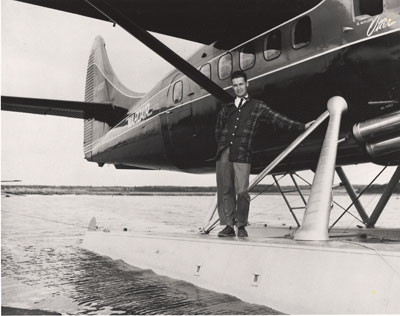
Features
Operations
100 Years of Powered Flight in Canada
Aviation-minded people of all ages and nationalities tend to have an inner desire to do something notable to fulfil their dreams.
July 27, 2009 By Raymond Canon
Aviation-minded people of all ages and nationalities tend to have an inner desire to do something notable to fulfil their dreams. For some, it may be to become a pilot – jet or otherwise. Another wish may well be to own an aircraft. Some people actually achieve their goals and for many others, the desire remains simply a dream.
 |
|
| Max Ward with a Wardair de Havilland Otter. |
One of these aviation enthusiasts was Max Ward. A native of Edmonton, he found the opportunity to explore aviation during the Second World War. He enlisted in the RCAF as a trainee pilot, won his wings, and spent the entire war at various bases instructing others in the art of flying. At the end of the war in 1945, he was discharged, and set about creating stage two of his flying career.
In the post-war period, there were aviation opportunities across Canada but there were far more aircraft and pilots than opportunities. The most successful solution was to find not only the right routes to fly but also the proper mix of aircraft. There was a lot of competition in the more populated south of Canada, and Trans Canada Airlines (with its government support) was vigorously trying to carve out as big a piece of the southern pie as possible. This meant slim pickings for Max Ward, so he wisely turned to the north, which he understood much better.
Max started out by using small biplanes such as the Fox Moth to carry both passengers and freight. This was a positive business move, and “expansion” became the key word in Ward’s aviation vocabulary.
In 1953 Ward took another important step – the creation of Wardair. He chose an eclectic mix of aircraft suited to the north, one of which was the single-engined Otter from de Havilland’s famous STOL prodigy. This was soon followed by three of the lesser-known twin-engined workhorse – the Bristol Freighter, an aircraft that superbly fit Ward’s requirements.
In 1962 came the next great leap forward with the lease of a Douglas DC-6B, which opened up valuable charter markets to Europe in the summer and to various southern destinations including Mexico, the Caribbean and the U.S. in the winter. Ward was on a roll. Other jets followed, including a Boeing 727, the first Boeing jet in Canada. In 1973 came the ultimate in aircraft – the Boeing 747 jumbo jet.
Wardair’s emphasis was first and foremost to establish a level of quality that did nothing less than astound the flying public. Your humble scribe confesses to having been among the astounded. For years I had flown on numerous airlines, compared levels of service, and resolutely settled on Swissair as the best of the best. My first flight on Wardair irrevocably changed my mind. From then on, I was a true fan of the airline’s unequalled quality of service.
It would be nice to report that Wardair went from victory to victory. However, storm clouds are a constantly occurring factor in aviation annals and no airline completely escapes them. Wardair’s problems were both internal and external. It had no domestic lines to supply it with passengers for its international routes and it also failed to attract a sufficient number of business flyers. Externally, there were public and quasi-public organizations that believed Canada could not support three major airlines. Air Canada was the chosen airline to represent the country, and Canadian Pacific Airlines (CP Air), it was argued, could pick up the rest of the trade.
In spite of having ordered 38 new aircraft in 1986, three years later Max Ward was forced to sell his prize airline to the number two carrier – Canadian Airlines International (formerly CP Air). The name “Wardair” soon disappeared.
Is Max Ward’s concept of quality lost on the Canadian public? Perhaps not. In an interview I had with Robert Deluce, president and CEO of Toronto’s Porter Airlines, I suggested a possible similarity between his airline and Wardair. He smiled and replied that Porter did reflect Wardair’s qualities such as increased seat space, pleasant and efficient service, and free meals consisting of more than “coffee and pretzels.”
Since 1989, Max Ward has won numerous awards as well as a number of honorary doctorates from Canadian universities. Perhaps another special honour is in order – the DAQ – Doctor of Aviation Quality.
– By Raymond Canon